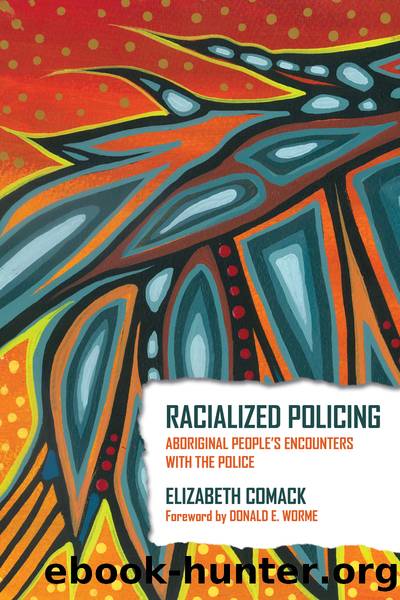Racialized Policing by Elizabeth Comack

Author:Elizabeth Comack
Language: eng
Format: epub
Publisher: Fernwood Publishing
Published: 2013-01-15T00:00:00+00:00
Chapter Six
POLICING WINNIPEGâS
INNER-CITY COMMUNITIES
Despite its moderate size relative to other Canadian cities, Winnipeg has garnered a reputation as a city ridden with crime and violence. In 2004 the city ranked first among the nine major metropolitan centres for its rate for homicides, robberies, and motor vehicle thefts. It ranked second for break-ins (Statistics Canada 2005). More recently, in 2009 Winnipeg ranked first among the census metropolitan areas on the violent crime severity index (Dauvergne and Turner 2010).
Much of this activity has been concentrated in Winnipegâs inner-city communities. A 2004 study by the Canadian Centre for Justice Statistics found that the closer one goes to the geographic core of Winnipeg, where the incidence of poverty and related problems is high, the higher is the incidence of crime. Robin Fitzgerald and his colleagues (2004: 8) concluded, âAfter taking into account all other factors, the level of socio-economic disadvantage of the residential population in a neighbourhood was most strongly associated with the highest neighbourhood rates of both violent and property crimes.â Other studies (see, for example, Lezubski, Silver, and Black 2000; Kazemipur and Halli 2000) reveal that for Winnipeg, rates of poverty, unemployment, and limited labour force participation â in other words, âsocio-economic disadvantageâ â are considerably worse in the inner city than in Winnipeg as a whole. The poverty rate in Winnipegâs inner-city communities, for instance, was 39.6 percent in 2006 compared with 20.2 percent for the city as a whole (MacKinnon 2009). Crime and violence, therefore, correlate strongly with poverty and related conditions, and both are more prevalent in Winnipegâs inner-city neighbourhoods.
Much like other Prairie cities in Canada, Winnipeg is home to a large number of Aboriginal people. In 2006 about one-third of all Aboriginal persons in Manitoba lived in Winnipeg. Of major cities in Canada that year, Winnipeg had the highest density of Aboriginal people (68,385), representing 9.8 percent of the total Winnipeg Central Metropolitan Area population (United Way Winnipeg 2010: 40). Aboriginal people make up some 21 percent of the population of Winnipegâs inner-city communities (MacKinnon 2009: 32); 65 percent of Aboriginal households in those inner-city communities were living in poverty in 2006 (MacKinnon 2009: 30).
It is within this context of crime, violence, and racialized poverty in Winnipegâs inner-city communities that encounters between Aboriginal people and the police are most likely to occur.* Indeed, it is in this area and among these people that the Winnipeg Police Service has concentrated much of its resources.
RACIALIZED POVERTY, CRIME, AND VIOLENCE IN THE INNER CITY
Criminologists have long recognized the correlation between poverty and certain forms of criminal activity. One of the primary factors that can account for this povertyâcrime correlation is the impact of changes in the global economy at the local level. Among the consequences of globalization â the integration of national economies into a global network â has been a shift in Canada from industrial to ânon-standardâ and service-sector jobs (Broad 2000; Broad, Cruikshank, and Mulvale 2006). Many industrial jobs that were unionized, paid a living wage, and offered reasonable
Download
This site does not store any files on its server. We only index and link to content provided by other sites. Please contact the content providers to delete copyright contents if any and email us, we'll remove relevant links or contents immediately.
The 1921 Tulsa Race Massacre by Chris M. Messer(284)
Introduction to Criminal Justice - A Balanced Approach by Brian K. Payne Willard M. Oliver Nancy E. Marion(253)
Russia's Sakhalin Penal Colony, 1849â1917 by Andrew A. Gentes(247)
Punishing the Poor The Neoliberal Government of Social Insecurity by Unknown(246)
The History of Newgate Prison by Jowett Caroline;(235)
Serial Killers America and UK - 2 BOOKS IN 1 by Clark Matthew(209)
A History of Police and Masculinities, 1700-2010 by David G. Barrie Susan Broomhall(195)
Restorative Justice in Transitional Settings by Kerry Clamp(168)
Organized Crime and Corruption Across Borders by T. Wing Lo Dina Siegel Sharon I Kwok(158)
Culture, Crime and Punishment by Ronald Kramer(155)
Cops, Cameras, and Crisis by Michael D. White Aili Malm(153)
Dangerousness, Risk and the Governance of Serious Sexual and Violent Offenders by Karen Harrison(152)
Policing Gender, Class And Family In Britain, 1800-1945 by Linda Mahood(151)
Routledge Handbook on Immigration and Crime by Holly Ventura Miller Anthony Peguero(150)
The Real CSI by Kate Bendelow(149)
Women Exiting Prison by Bree Carlton Marie Segrave(140)
Losing Legitimacy by Gary Lafree(138)
Using Murder by Philip Jenkins(135)
A Theory of African American Offending by James D. Unnever Shaun L. Gabbidon(134)
